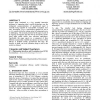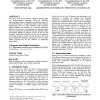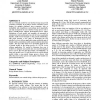BCSHCI
2007
14 years 27 days ago
2007
Sketch-based tools provide a more human centered design environment than traditional widget-based computer design software. A number of sketch tools exist that support specific de...
BCSHCI
2007
14 years 27 days ago
2007
BCSHCI
2007
14 years 27 days ago
2007
We seek to close the gap between software engineering (SE) and human-computer interaction (HCI) by indicating interdisciplinary interfaces throughout the different phases of SE an...
BCSHCI
2007
14 years 27 days ago
2007
An experimental validation is presented of a novel method for usability testing that entails the playback of dynamic eyetracking data to cue the elicitation of retrospective verba...
BCSHCI
2007
14 years 27 days ago
2007
This paper surveys the use of inferential statistics over the last two BCS HCI conferences and the last year (2006) of two leading HCI journals. Of the 80 papers covered, 41 used ...
BCSHCI
2007
14 years 27 days ago
2007
The use of formal models for user interface design can provide a number of benefits. It can help to ensure consistency across designs for multiple platforms, prove properties such...
BCSHCI
2007
14 years 27 days ago
2007
Eye-tracking research is increasingly used to supplement usability tests in both commercial and academic practice. However, while there has been research into links between eyetra...
BCSHCI
2007
14 years 27 days ago
2007
The present study explores potential usability gaps when users switch from a familiar to an unfamiliar mobile phone interface. A within-subject experiment was performed in which n...
BCSHCI
2007
14 years 27 days ago
2007
This paper describes an approach to support non-visual exploration of graphically represented information. We used a hierarchical structure to organize the information encoded in ...
BCSHCI
2007
14 years 27 days ago
2007
In this paper, we introduce GazeSpace, a novel system utilizing eye gaze to browse content spaces. While most existing eye gaze systems are designed for medical contexts, GazeSpac...



